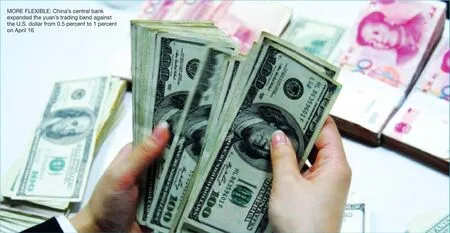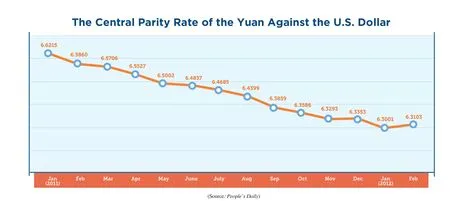Wider Trading Limit
2012-10-16ChinaisdeterminedtoadvanceexchangeratereformandimprovetheyuanpricingmechanismByLiuXinlian
China is determined to advance exchange rate reform and improve the yuan’s pricing mechanism By Liu Xinlian
Wider Trading Limit
China is determined to advance exchange rate reform and improve the yuan’s pricing mechanism By Liu Xinlian
Aside from meeting overseas clients,exhibitors at the 111th Canton Fair,China’s biggest export fair which kicked off on April 15 in southeast China’s Guangdong Province, were also concerned with the new move in the yuan-dollar trading band.
On April 16, the People’s Bank of China,the central bank, widened the trading band for the yuan against the U.S. dollar to 1 percent from 0.5 percent.
“The yuan will witness more fl uctuations in the future. We must get ready for that,” said Gao Yuanjia, General Manager of Chunlan Import and Export Co. Ltd., an air conditioner maker and exporter based in east China’s Jiangsu Province.
In the foreign exchange spot market,Chinese banks can exchange the yuan 1 percent above or below the central parity against the U.S. dollar announced by the China Foreign Exchange Trading System each trading day. Previously, the daily trading limit was set at 0.5 percent.
This is the fi rst time China has widened its trading band against the greenback since 2007.
Adjusting to market demand, widening the yuan’s trading band aims to promote the currency’s exchange, boost its two-way fl uctuation flexibility and improve the marketbased managed fl oating exchange rate regime tied to a basket of foreign currencies, said the central bank.
“A more fl exible yuan will help identify market supply and demand and promote the yuan’s price to reach an equilibrium level,which will facilitate the exchange rate reform,” said Ding Zhijie, Dean of the School of Banking and Finance at the University of International Business and Economics.
It is considered a symbolic move by the central bank, as the widening of the trading band implies the trend for the yuan’s one-way appreciation has come to an end.
The move has unveiled China’s attempts to speed up market-based currency exchange rate reform. But it also means more trading risks for its exporters and banks.
Right timing
“The central bank’s move has been much anticipated for a long time,” said Lu Zhengwei,chief economist of the Industrial Bank based in southeast China’s Fujian Province.
In the past seven years after the exchange rate reform since 2005, China has insisted on propelling the internationalization of the yuan.
It has successively allowed yuan settlement in cross-border trade, foreign and outbound direct investments, and launched the pilot program of RMB Quali fi ed Foreign Institutional Investors.
The yuan’s value increased some 30 percent against the U.S. dollar since 2005.
The move came as China’s shrinking trade surplus has eased the yuan’s appreciation expectation, said Lian Ping, chief economist with the Bank of Communications.
The country saw a trade deficit of $31.48 billion in February, the largest monthly de fi cit in a decade, making trade surplus narrow to $670-million in the fi rst quarter, compared with $2.22 billion during the same period of last year.

XINHUA

Now is a good time to expand the trading band, said Wang Tao, head of the China economic research at UBS Securities.
Since the ratio of China’s current account surplus to the GDP has dropped to less than 3 percent and is likely to remain low, the yuan exchange rate against the U.S. dollar should not still be seen as substantially undervalued, said Wang.
Meanwhile, China’s foreign exchange market is quickly developing and trading entities are more capable of pricing independently and managing their risks, said the central bank.
Impacts
Expanding the yuan’s fl oating band is a signi ficant step of the yuan’s trading reform, but will also increase trading risks for banks and exportoriented companies in the short run, said Lian.
“It will be hard for Chinese exporters to get used to two-way fl uctuations since most of them are used to one-way moves. It means the yuan will fluctuate more dramatically,” said Yuan Shiyi, Vice Manager of International Trade Department of Guangdong New Pearl Ceramics Group.
The move will also affect manufacturing costs, said Liu Jianjun, Deputy Director General of the China Foreign Trade Center under the Ministry of Commerce. He suggested exporters boost global competitiveness and pricing ability.
The new trading band will encourage more companies to settle trade directly in the yuan, said Liao Qun, chief economist at the CITIC Bank International.
But in the short term, exporters and banks should make preparations against risks stemming from exchange rate fl uctuations, said Lian.
Lian suggested exporters buy financial derivatives to hedge foreign exchange trading risks and banks strengthen risk management on foreign exchange assets.
“Enterprises have to spend certain costs to guard against risks,” Lu said.
“If China’s export enterprises could always pay close attention to the exchange rate fl uctuation and form our own risk prevention system, we can make a higher pro fi t by seizing the right time to make deals,” said Gao.
“Only after exporters get adapted to the fl uctuations, can the yuan’s price re fl ect true market conditions,” said Lu.
Milestones As the Yuan Goes Global
● April 14, 2012 The People’s Bank of China (PBC), the central bank, widened the yuan’s trading bandagainst the U.S.dollar to 1 percent from 0.5 percent.
● January 13, 2011 The PBC launched a pilot scheme for the yuan settlement of overseas direct investments by domestic companies.
● July 19, 2010 The PBC and the Hong Kong Monetary Authority agreed to expand the yuan trade settlement and clearing in Hong Kong, staring the offshore trading of the yuan.
● July 2009 The Chinese Government launched a pilot program of the yuan settlement in cross-border trade transactions.
● June 2007 China Development Bank issued yuan-denominated bonds in Hong Kong, which is the fi rst yuan bond launched outside the Chinese mainland.
● July 21, 2005 China unpegged the yuan to the U.S. dollar and shifted to a managed fl oating exchange rate regime based on market supply and demand with reference to a basket of currencies.
